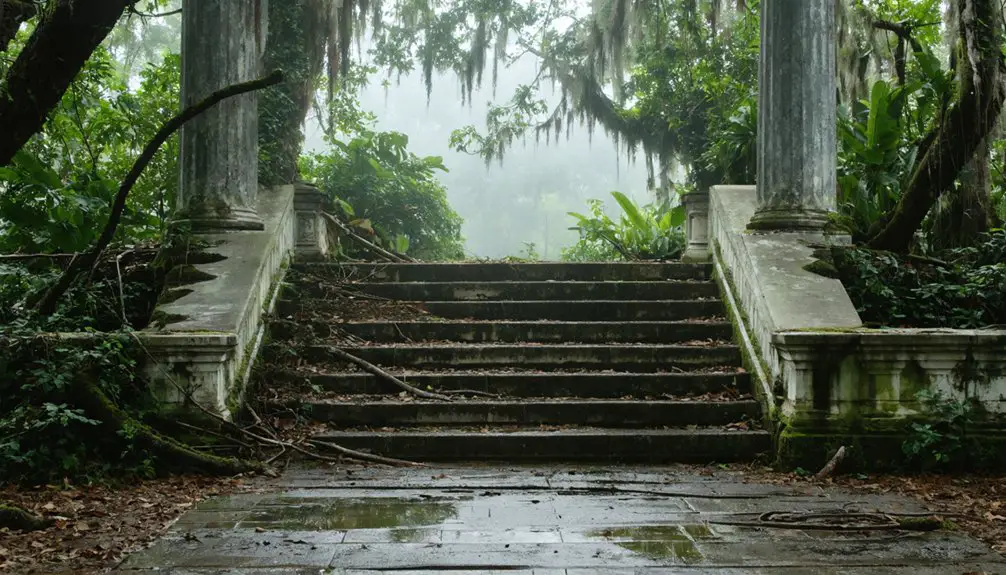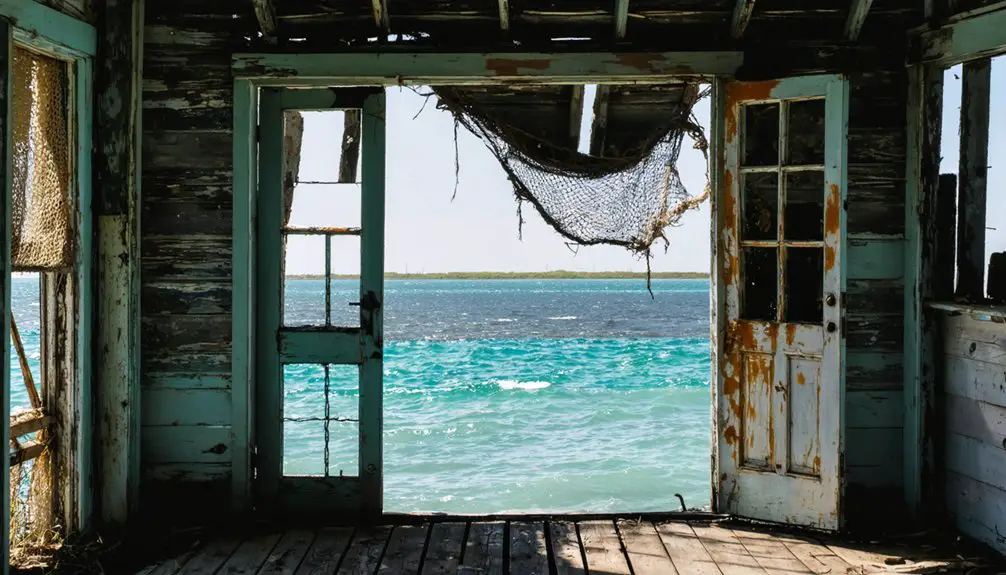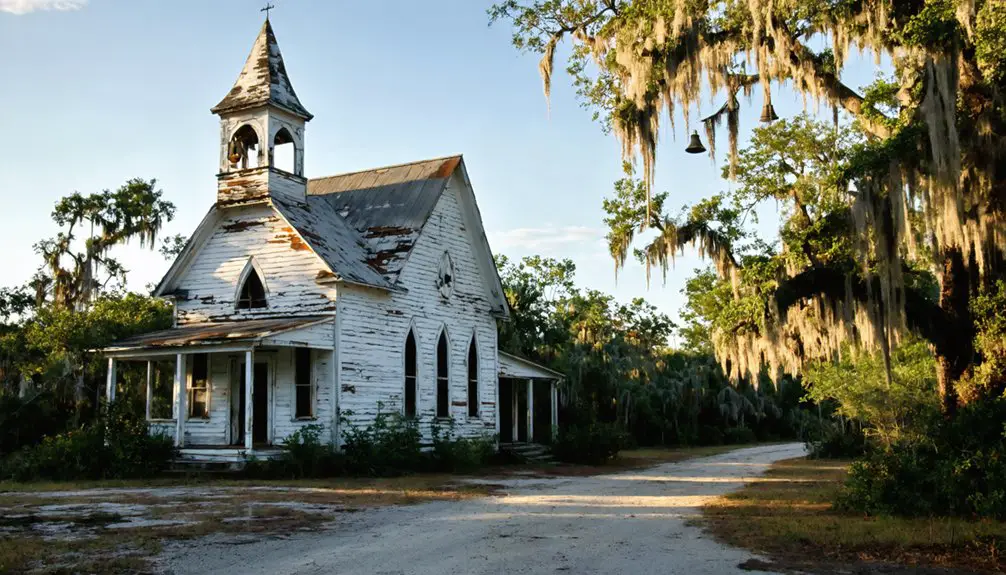You’ll discover Florida’s most intriguing ghost towns scattered across the state’s diverse landscape. Fort Dade’s military ruins stand guard at Tampa Bay’s entrance, while Eldora’s abandoned citrus groves whisper tales of the Great Freeze. Hampton Springs’ crumbling resort, Fort Drum’s cavalry outpost, and Ellaville’s industrial remnants showcase distinct chapters of Florida’s past. Each site, from Yukon’s military transformation to forgotten settlements, holds fascinating stories within their weathered remains.
Key Takeaways
- Fort Dade on Egmont Key features deteriorating military structures from 1898, including battery positions and brick roads network.
- Ellaville, once Florida’s largest lumber town with 1,000 residents, declined after natural disasters destroyed its sawmill operations.
- Eldora thrived on citrus production until the devastating Great Freeze of 1894-95, now preserved within Canaveral National Seashore.
- Hampton Springs’ ruins tell the story of a luxury health resort with sulfur springs, destroyed by fire in 1954.
- Fort Drum evolved from a military outpost to a cattle settlement, leaving only a historic cemetery as evidence.
The Strategic Ruins of Fort Dade
While many of Florida’s coastal fortifications have vanished into history, the haunting ruins of Fort Dade on Egmont Key stand as a proof to America’s maritime defense strategy at the dawn of the 20th century.
You’ll find this former military stronghold at the mouth of Tampa Bay, where it once protected one of Florida’s most essential ports from Spanish invasion threats.
Established in 1898, Fort Dade’s military architecture reflects the era’s coastal defense priorities, with its strategic battery positions and extensive brick road network.
Fort Dade’s 1898 construction embodied state-of-the-art coastal fortification, featuring advanced artillery placements and carefully engineered transportation infrastructure.
Today, the site attracts history enthusiasts seeking to explore its abandoned military outpost remains, though much of the original structure has eroded over time.
You can still trace these pathways through the deteriorating remains of what was once a thriving community of up to 600 residents. The fort offered modern amenities including electricity and hospitals for its inhabitants.
During World War I, the fort served as a crucial training center for National Guard artillery units before its eventual deactivation in 1923, leaving behind the silent sentinels of America’s coastal defense heritage.
Eldora: A Citrus Paradise Lost to Nature
A once-thriving citrus paradise, Eldora emerged in 1882 along Florida’s Mosquito Lagoon, where you’ll now find its remnants within Canaveral National Seashore. Named after sisters Ellen and Dora, this waterfront community flourished through fishing, hunting, and its crucial citrus legacy until the devastating Great Freeze of 1894-95 destroyed the town’s economic foundation.
The town relied heavily on the Indian River waterway for transportation and commerce during its peak years. Today, you can explore Eldora’s transformed landscape, where nature has reclaimed what humans left behind. The restored Eldora House serves as a weekend museum, while the surrounding wilderness hosts diverse wildlife and supports marine research facilities. Many visitors report encountering eerie supernatural phenomena while exploring the abandoned ruins.
At just three feet above sea level, this ghost town’s ecological significance continues through joint studies by Daytona State College and the University of Central Florida, preserving both natural wonders and historical memories for future generations.
Fort Drum’s Military Legacy and Rural Past
You’ll find Fort Drum’s origins as a strategic U.S. Army frontier defense post at the crossroads of two essential military roads, where it served to control central Florida’s territory between the Second and Third Seminole Wars from 1849 to 1861.
After the fort’s abandonment, the area transformed into a ranching community in the 1870s as settlers, including Henry Hancock, were drawn to the fertile grazing lands. Like the 10th Mountain Division today, these early military outposts played a crucial role in shaping American military presence in their regions. During World War II, the installation saw massive growth with the addition of 75,000 acres of land.
The site’s military and pioneer heritage lives on through its historic cemetery and local oral traditions, though no physical remains of the original fort survive today.
Strategic Frontier Defense Post
Located at the strategic intersection of two essential military thoroughfares in central Florida, Fort Drum emerged as a significant frontier defense post in 1849 following the Second Seminole War.
You’ll find its historic site near Drum Creek, where the east-west route from Fort Bassinger to Fort Vinton crossed the north-south “old wire road” connecting Fort Kissimmee to Fort Jupiter.
While you won’t witness any major battles in Fort Drum’s history, its position was critical for military logistics and protecting frontier settlements. Like its modern namesake in New York that trains 80,000 troops annually, the original Fort Drum played a vital role in military preparedness.
The fort’s brief operational period included initial deactivation in 1850, a short reoccupation in 1856, and final abandonment in 1861 as Civil War priorities shifted. The fort was established at where roads crossed to maximize its strategic defensive position.
Though no physical remains exist today, Fort Drum’s legacy lived on as settlers transformed the area into a thriving agricultural community by the 1870s.
Ranching Community Development
While Fort Drum’s military importance waned after 1861, the region’s fertile grazing lands attracted pioneering settlers in the 1870s who transformed the former frontier defense post into thriving cattle country.
This ranching heritage became the cornerstone of Fort Drum’s identity, with the cattle economy flourishing alongside a growing rural community.
Later in 1908, the area would see a revival of its military significance as training grounds were established, marking a new chapter in Fort Drum’s history.
Here’s what shaped Fort Drum’s development as a ranching community:
- The arrival of the Florida East Coast Railroad in 1914 revolutionized cattle transport and market access.
- Small depots at Fort Drum, Osawaw, and Hilolo supported expanding livestock operations.
- Former military roads provided essential infrastructure for moving cattle and supplies.
- Cooperation among ranchers emerged to manage the semi-wild environment sustainably.
You’ll find that Fort Drum’s evolution from military outpost to ranching center exemplifies the pioneering spirit of Florida’s cattle country.
Historic Cemetery Preservation
The historic Fort Drum Cemetery, spanning nearly 8 acres with 381 internments, stands as a tribute to Florida’s multifaceted past since 1876.
You’ll find the graves of the region’s first settlers, including pioneer Henry Parker, who traded with Seminole Indians, marking the cemetery’s deep historical significance in preserving the area’s heritage.
Cemetery restoration efforts reflect the community’s dedication to maintaining this essential link between Native American, pioneer, and military histories. The Directorate of Public Works now oversees the careful preservation of these sacred grounds.
The site, originally established near a Seminole War fort from the 1840s, preserves the legacy of pioneer families like the Biggs, Flints, and Pennington’s.
Notable family names etched in stone tell the story of Fort Drum’s transformation from a military outpost to a thriving pioneer settlement, making it an irreplaceable historical treasure.
Hampton Springs: From Wellness Resort to Wilderness

Before becoming a wilderness of scattered ruins, Hampton Springs stood as one of Florida’s premier wellness resorts, born from a Native American legacy of healing sulfur springs.
Early settler Joe Hamilton discovered these therapeutic waters through indigenous guidance, leading to the Hampton brothers’ ambitious vision of wellness tourism in 1879.
- You’ll discover the remnants of a once-luxurious resort that featured a casino, ballroom, and spring-fed swimming pool.
- You can explore historical ruins from the 1908 hotel, which expanded in 1915 to include elaborate gardens and fountains.
- You’ll find the still-flowing sulfur springs that attracted thousands seeking natural healing.
- You can walk through what remains of this ghost town, destroyed by fire in 1954, where legends of supernatural occurrences persist.
Today, nature reclaims this haunting memorial to Florida’s early resort era, preserving its mystique for modern explorers.
Tales From Abandoned Ellaville
As you venture along the banks of the Suwannee River, you’ll discover the remnants of Ellaville, a once-thriving lumber town founded in 1861 by George Franklin Drew that grew to house 1,000 residents.
The town’s meteoric rise centered around Florida’s largest steam-operated sawmill, which employed over 500 workers and established Ellaville as a crucial transportation hub with its railroad line and steamboat dock.
You can still explore traces of this vanished community within Suwannee River State Park, where the ruins of the Drew mansion, historic Hillman Bridge, and old cemetery stand as silent witnesses to Ellaville’s transformation from industrial powerhouse to abandoned ghost town by the mid-20th century.
Rise and Fall History
Founded in 1861 by future Florida governor George Franklin Drew, Ellaville emerged as a thriving industrial town on the western bank of the Suwannee River.
You’ll find a remarkable story of rapid growth and eventual decline, centered around what became Florida’s largest sawmill operation. Drew, nicknamed “Millionaire Drew,” transformed this frontier settlement into a bustling economic powerhouse.
Key elements of Ellaville’s rise and fall:
- The sawmill employed 500 workers, driving population growth to 1,000 residents by the 1870s.
- Strategic infrastructure included railroad connections, churches, schools, and a steamboat dock.
- Natural disasters and declining lumber industry triggered the town’s economic decline.
- By the 1970s, most structures were abandoned, with the Drew Mansion’s burning marking the end of an era.
Today, nature has reclaimed this once-prosperous town, leaving only scattered remnants of its historical significance.
Madison’s Lost River Hub
While the Suwannee River flows steadily today through Madison County’s wilderness, you’ll discover the haunting remnants of Ellaville‘s once-bustling river hub scattered along its western banks.
You’re walking through what was Florida’s largest steam-operated sawmill town, where over 500 workers once powered a thriving lumber industry. At its peak in the 1870s, you’d have found 1,000 residents, a railway connection to Jacksonville, and a steamboat dock defining this crucial trading post.
Founded by future Florida Governor George Franklin Drew and named after his servant Ella, the town boasted churches, schools, and a Masonic lodge.
Today, you’ll find only the Hillman Bridge and weathered trails where the Drew Mansion once stood, with nature reclaiming this significant piece of Suwannee River history.
Structures Through Time
Through decades of change and decay, Ellaville’s structural legacy tells a compelling story of Florida’s industrial past.
As you explore the remnants of this once-thriving river town, you’ll discover how Ellaville’s infrastructure supported a dynamic community of 1,000 residents during its 1870s peak. The economic transformation centered around Drew’s massive sawmill operation, which employed 500 workers and drove the town’s prosperity.
- The grand Drew Mansion stood as a symbol of wealth until its tragic burning in the 1970s.
- The sawmill complex, once Florida’s largest, powered the town’s industrial might.
- Two churches and schools formed the community’s cultural backbone.
- The surviving Hillman Bridge and railroad bridge remain as silent witnesses to Ellaville’s transportation network.
The town’s structures, though mostly gone, paint a vivid picture of post-Civil War entrepreneurial spirit.
Yukon’s Military Transformation
During the late 19th century, Canada’s concerns over potential U.S. territorial expansion sparked the creation of the Yukon Field Force in May 1898. This 203-strong militia force established headquarters at Fort Selkirk, reflecting Canada’s commitment to preserving Yukon sovereignty and military history in the region.
You’ll find that Yukon’s military landscape transformed dramatically during World War II when it became a crucial operational hub under the Northwest Service Command in 1942. The territory’s strategic importance led to increased military infrastructure, though this strained local resources, particularly affecting the White Pass and Yukon Route railway’s civilian operations.
While the Yukon Regiment‘s formation in 1962 marked a new chapter in territorial defense, it was short-lived, being reduced to nil strength by 1968. These developments showcase Yukon’s evolution from gold rush-era security concerns to modern military considerations.
Florida’s Hidden Historical Ghost Towns

As the remnants of Florida’s bygone settlements fade into the landscape, you’ll discover a diverse collection of ghost towns that tell stories of military outposts, agricultural ventures, and health resorts.
These hidden treasures reveal forgotten narratives of ambition, prosperity, and ultimate abandonment across the Sunshine State.
- Fort Dade stands as a symbol of military history, where you’ll find deteriorating brick roads and staircases on Egmont Key, once home to 600 residents.
- Eldora’s citrus empire crumbled after the devastating Great Freeze of 1895, leaving only the restored Eldora House.
- Fort Drum chronicles the shift from military outpost to cattle settlement, marked by its historic cemetery.
- Hampton Springs’ healing waters once drew visitors to its luxurious hotel, now reduced to ruins that echo Florida’s health tourism era.
Preserving Florida’s Lost Communities
While Florida’s ghost towns face mounting preservation challenges, dedicated state programs and grassroots initiatives work to safeguard these historical treasures.
You’ll find state support through various grant programs, including Special Category and Small Matching Grants, though these are limited to government entities and nonprofits. Community engagement plays a crucial role, with volunteers and local historians actively restoring significant structures like Eldora’s State House.
The preservation challenges are substantial, as Florida’s late start in heritage protection has left many sites vulnerable to development pressures and natural degradation.
You’ll discover that successful preservation efforts now integrate archaeological surveys, environmental conservation, and tourism development. These combined approaches help protect vanished settlements while creating sustainable ways to share Florida’s rich history with visitors.
Frequently Asked Questions
Are There Guided Ghost Tours Available at Any of These Abandoned Towns?
You’ll find guided tours at Fort Dade on Egmont Key, where you can explore military ruins and ghost experiences. Most other Florida ghost towns don’t offer structured ghost tours, requiring independent exploration.
What Safety Precautions Should Visitors Take When Exploring These Ghost Towns?
Wear proper safety gear including sturdy boots, gloves, and protective masks. Stay alert for wildlife, explore in groups, and bring water and first-aid supplies. Don’t enter unstable structures or trespass on private property.
Can Metal Detecting or Artifact Collecting Be Done at These Sites?
You’ll need special permits for metal detecting, as most ghost towns are protected by strict regulations. Don’t collect artifacts – they’re essential for preservation and removing them is typically illegal under state laws.
Which Ghost Towns Are Accessible During Florida’s Rainy Season?
You’ll find Suwannee River State Park’s ghost towns most reliably accessible during rainy season, while Fort Dade’s weather-dependent boat access and inland sites like St. Johns River require careful timing around storms.
Are There Camping Facilities Near Any of These Abandoned Settlements?
You’ll find campground amenities at Fort De Soto Park near Egmont Key, while primitive camping regulations apply near Fort Drum and Hampton Springs. State parks and wildlife areas offer varied camping options nearby.
References
- https://patchproflorida.com/blog/the-fascinating-history-of-floridas-ghost-towns/
- https://www.florida-backroads-travel.com/florida-ghost-towns.html
- https://www.ghosttowns.com/states/fl/fl.html
- https://www.freakyfoottours.com/us/florida/
- https://www.youtube.com/watch?v=bNjqcQ5SMwg
- https://www.clickorlando.com/features/2024/09/25/floridas-creepiest-ghost-town-is-stashed-on-an-island-heres-the-lowdown/
- https://www.thetravel.com/unique-history-of-fort-dade-abandoned-town/
- https://www.floridastateparks.org/learn/history-egmont-key
- https://www.legendsofamerica.com/fort-dade-egmont-key/
- https://www.natalijaugrina.com/post/florida-ghost-town



